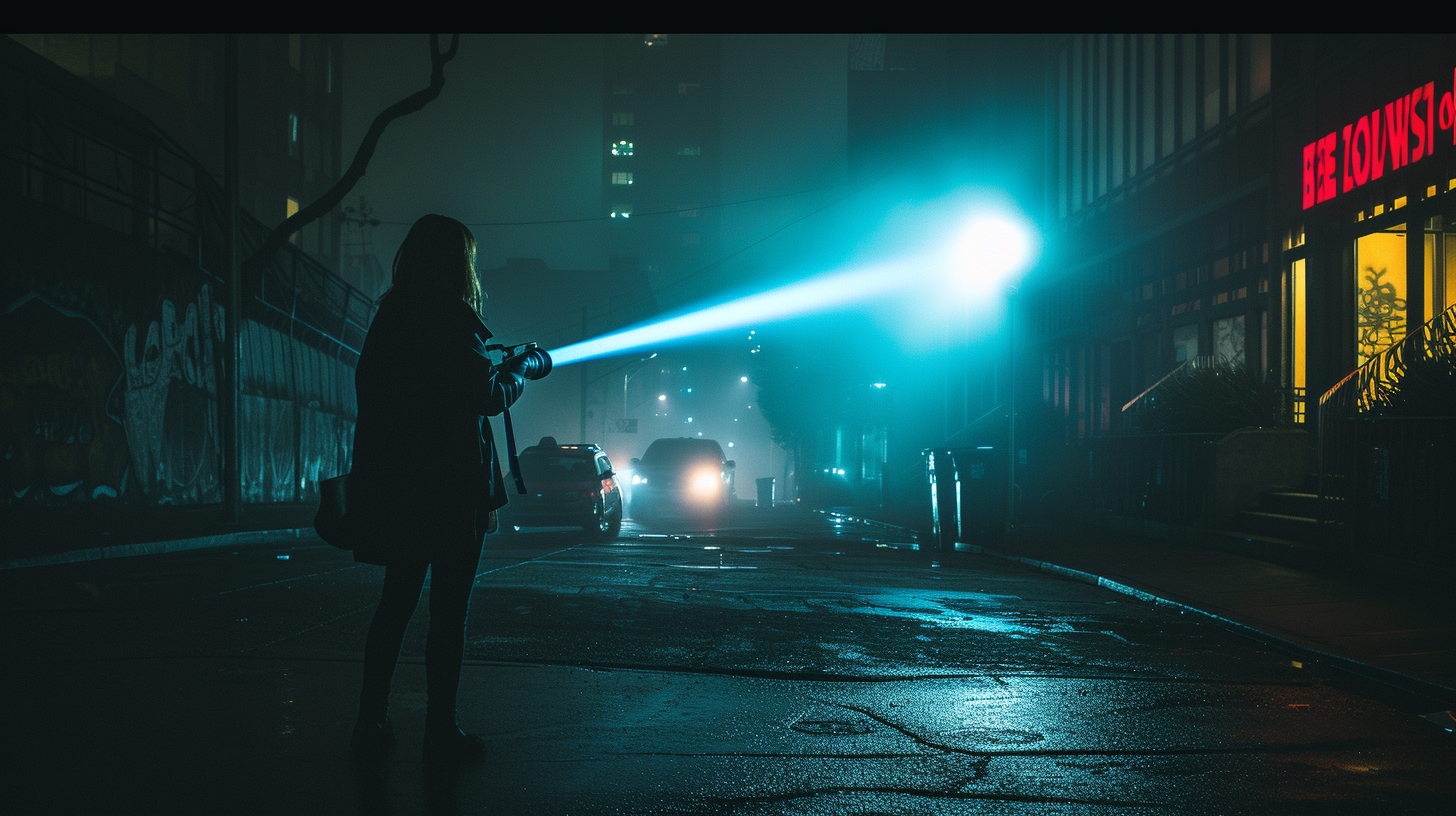What Is a Purple Flashlight Used For?
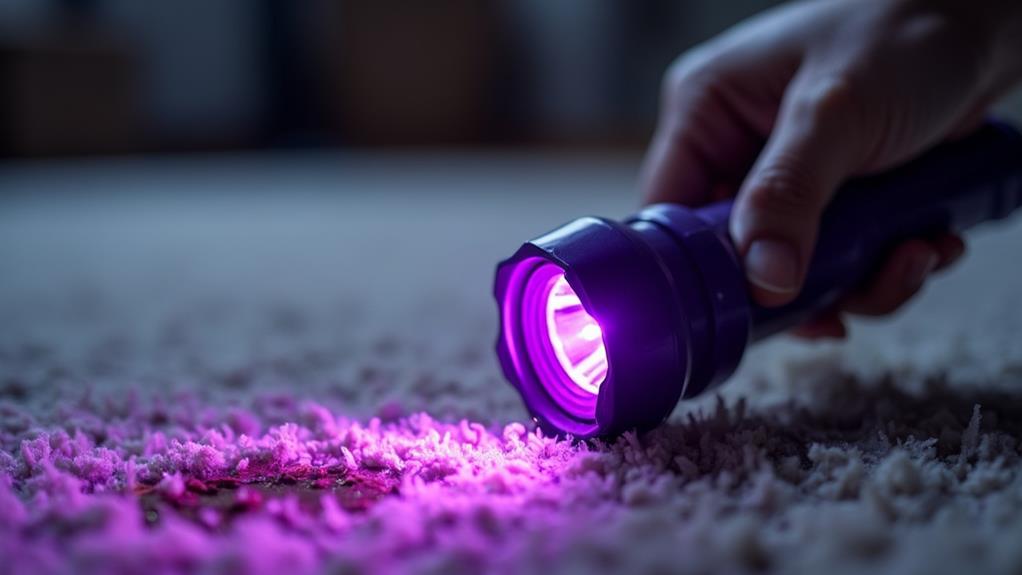
Imagine holding a purple flashlight, commonly known as a UV flashlight. You might wonder why such a tool is necessary. It's not just a quirky gadget; it has practical uses across various fields. From detecting pet stains and verifying counterfeit money to aiding forensic investigations and scientific research, its applications are extensive and intriguing. But what makes it so special, and how can you use it effectively in your daily life or profession? Let's explore its unique capabilities and uncover the secrets it reveals.
Understanding UV Flashlights

A UV flashlight, often referred to as a purple flashlight, is a versatile tool that serves purposes beyond standard illumination. Emitting ultraviolet (UV) light, which is invisible to the naked eye, these flashlights cause certain materials to fluoresce or glow. UV light typically ranges from 365 nm to 395 nm, with 365 nm being the most effective for detecting fluorescence.
UV flashlights have numerous practical applications. For instance, they are excellent for locating pet stains that are otherwise invisible in normal light. Simply shine the flashlight in areas where your pet might have had an accident, and the stains will glow, making cleanup much easier.
These flashlights are also invaluable for counterfeit detection. When you hold the UV light over currency or important documents, hidden security features become visible, helping you verify authenticity.
Additionally, UV flashlights are frequently used in forensic investigations. They can reveal bodily fluids and enhance latent fingerprints, aiding in crime-solving. Beyond that, they can be used to inspect the cleanliness of hotel rooms by illuminating biological residues like mold and mildew, ensuring a hygienic stay. Understanding UV flashlights opens up a world of practical applications you might not have considered.
Forensic and Verification Uses
Forensic and verification applications of purple flashlights showcase their remarkable utility in professional settings. In forensic investigations, a purple flashlight emitting ultraviolet light is indispensable. It helps detect bodily fluids like blood and urine stains, which fluoresce under UV illumination, crucial for gathering evidence at crime scenes.
Purple flashlights are also essential for enhancing latent fingerprints on various surfaces. The UV light makes these prints more visible, allowing forensic experts to efficiently collect critical evidence. Beyond forensics, these flashlights are fundamental for counterfeit verification. By revealing hidden security features not visible under normal light, such as fluorescent strips in currency and IDs, they enable quick authentication of documents.
Moreover, many international currencies feature UV-reactive elements. With a purple flashlight, you can easily identify and verify these features, ensuring the legitimacy of the money. Forensic professionals also use these tools to assess cleanliness and hygiene in different environments. The UV light reveals biological contaminants invisible to the naked eye, aiding in the maintenance of high cleanliness standards. Whether for forensic or verification purposes, purple flashlights are a vital tool in your professional toolkit.
Scientific Applications
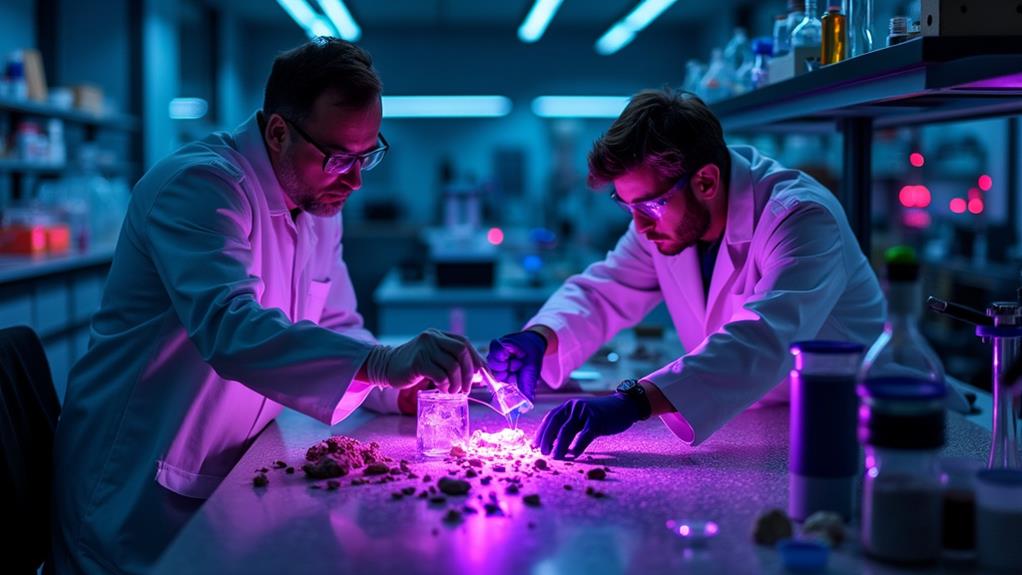
In scientific research, purple flashlights emitting UV-A light at around 365 nm are invaluable for revealing fluorescence in minerals and gemstones, aiding in their classification and identification. These UV lights detect distinctive colors and patterns that aren't visible under normal lighting conditions, making them indispensable for geologists and gemologists.
In laboratories, purple flashlights are essential for detecting biological materials and contaminants. Many substances fluoresce under UV light, enhancing the accuracy of analyses. This application is particularly useful in microbiology for identifying bacteria or other microorganisms that emit fluorescence.
Entomologists also benefit from purple flashlights. Studying insect behavior and population dynamics becomes easier as many insects fluoresce, making nighttime observation more effective. Detecting and tracking these insects is much simpler with a UV light.
In materials science, purple flashlights assist in analyzing polymers and dyes by revealing hidden features. These features might not be apparent under regular light but become clear with UV illumination.
Environmental Observation
Exploring the natural world at night becomes significantly more insightful with the use of purple flashlights that emit UV light. These flashlights make nocturnal insects and reptiles, which fluoresce under UV light, easier to spot. Whether you're camping, hiking, or just curious about nocturnal life, these portable, lightweight flashlights are ideal companions.
UV lights can also reveal the presence of certain minerals and materials not visible under regular lighting, enhancing environmental observation. For instance, some plants fluoresce due to their chemical composition, allowing for the identification of specific species and assessment of their condition even at night.
Furthermore, purple flashlights are invaluable for monitoring environmental health. They can detect signs of pollution or contamination by illuminating substances that fluoresce under UV light, thus identifying affected areas. This is crucial for researchers and enthusiasts dedicated to preserving natural ecosystems. So, pack a purple flashlight on your next adventure and experience the night in a whole new light.
Choosing the Right Flashlight
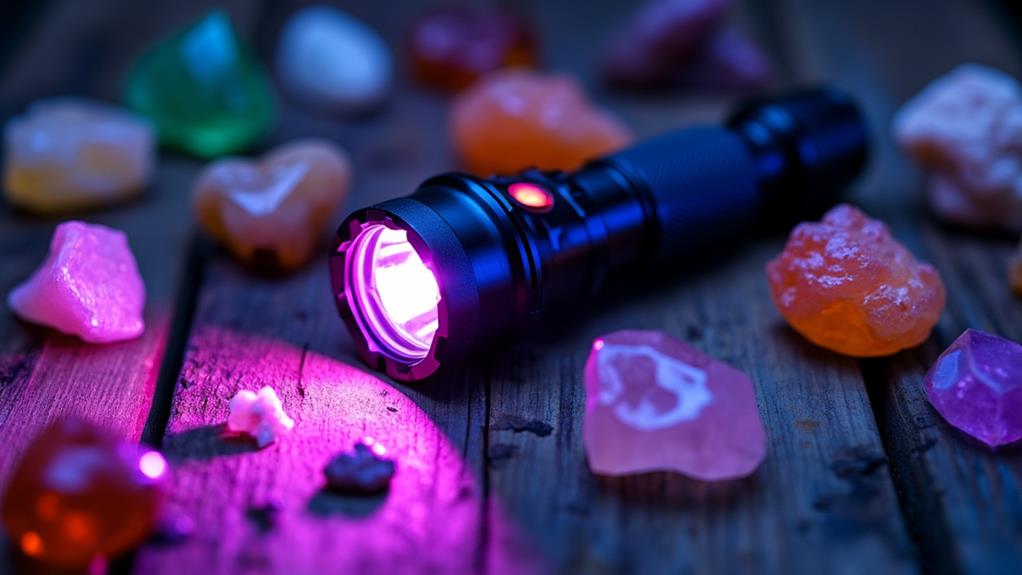
When selecting a purple flashlight, consider the wavelength, battery type, and durability. For optimal fluorescence detection, choose a model with a 365 nm wavelength. Rechargeable 18650 lithium-ion batteries are recommended for extended use. Ensure the flashlight is robust enough to withstand harsh conditions to ensure reliability.
Optimal Wavelength Selection
Selecting the appropriate UV flashlight is crucial for tasks involving fluorescence detection. Understanding wavelength selection can significantly impact the effectiveness of your work. The optimal wavelength for fluorescence detection is typically around 365 nanometers, as this range maximizes the visibility of fluorescing materials, making it ideal for identifying hidden stains and other substances. Conversely, higher wavelength LEDs, such as those around 415 nanometers, are less effective for true UV applications and do not yield the desired fluorescent effects.
When choosing a UV flashlight, consider the specific applications you have in mind. Different materials and tasks respond variably to UV wavelengths, so selecting the appropriate one is essential. Here are three key scenarios where the correct wavelength is crucial:
- Forensic Investigations: Essential for revealing hidden stains and evidence invisible to the naked eye.
- Counterfeit Detection: Critical for distinguishing genuine items from fakes by exposing concealed security features.
- Mineral Observation: Necessary for observing the unique fluorescence properties of various minerals.
Battery Type Preferences
Understanding the best wavelength selection is just one part of ensuring effective fluorescence detection; the choice of battery type in your UV flashlight is equally significant. Opting for the right battery can dramatically impact your UV flashlight's performance, longevity, and overall user experience. Rechargeable 18650 lithium-ion batteries are a popular choice due to their high capacity and longer lifespan compared to disposable AA or AAA batteries.
Consider your usage frequency. If you use your UV flashlight regularly, rechargeable batteries can save you money over time. Many UV flashlights also come with USB charging ports, adding convenience for recharging on the go. Protected 18650 batteries are especially recommended because they prevent overheating and leakage, ensuring safer operation during extended use.
The battery type you select impacts your flashlight's performance, especially when dealing with higher output wavelengths around 365 nm, which are most effective for fluorescence detection. A robust power source is crucial for optimal functionality.
Here's a quick comparison to help you decide:
| Battery Type | Capacity (mAh) | Convenience | Safety |
|---|---|---|---|
| 18650 | 2500+ | High | Moderate |
| AA | 1200 | Medium | High |
| AAA | 1000 | Low | High |
| USB Rechargeable | Varies | Very High | High |
| Protected 18650 | 2500+ | Very High | Very High |
Choosing the right battery can make all the difference in your UV flashlight's effectiveness.
Durability and Portability
Choosing a durable and portable flashlight is essential for improved performance and convenience. When selecting a flashlight, consider its durability by opting for materials like aircraft-grade aluminum or reinforced plastic. These materials are resilient, able to withstand drops and rough handling, ensuring the flashlight endures multiple adventures.
Portability is equally important. Choose lightweight models that are easy to carry. Flashlights with compact designs and belt clips provide added convenience, especially for outdoor activities. A lightweight flashlight won't be cumbersome, making it easier to bring along wherever you go.
Battery life significantly impacts both durability and portability. Flashlights with rechargeable options or long-lasting batteries, such as lithium-ion, offer reliability during extended use. This minimizes the need for frequent battery replacements and ensures your flashlight is ready when needed.
Water resistance is also crucial. Look for flashlights with water and dust resistance ratings (e.g., IPX4 or higher) to ensure they perform well in various environmental conditions, thereby increasing their longevity.
Key Points to Remember:
- Materials: Opt for aircraft-grade aluminum or reinforced plastic for durability.
- Design: Choose lightweight, compact models for portability.
- Battery: Select long-lasting or rechargeable options to enhance battery life.
- Water Resistance: Ensure the flashlight has a water and dust resistance rating of IPX4 or higher for longevity.
Powering UV Flashlights
When powering UV flashlights, options include disposable AA or AAA batteries and rechargeable 18650 lithium-ion batteries. Rechargeable models often feature USB ports, making them convenient and cost-effective for frequent use. Understanding the differences between these power sources, such as their impact on brightness and operational duration, is essential for selecting the right flashlight for your needs.
Common Power Sources
Powering UV flashlights efficiently depends on selecting the right power source. Among the common options, disposable AA or AAA batteries are widely available and easy to replace, making them convenient for quick and hassle-free swaps. However, for longer battery life and better performance, consider rechargeable 18650 lithium-ion batteries. These batteries typically have a capacity of 2500 mAh or more, providing extended usage times between charges.
Many modern UV flashlights feature USB charging ports, simplifying the recharging process without the need to replace batteries. This is particularly useful if you're on the go and can't afford downtime. Choosing the right power source offers several benefits:
- Reliability: Ensures your flashlight is operational when you need it most.
- Efficiency: Longer battery life reduces the frequency of recharging or replacing batteries.
- Safety: Protected 18650 batteries help prevent overheating and leakage, ensuring safe operation.
Ultimately, the power source you choose significantly impacts the performance and usability of your UV flashlight in various applications.
Battery Types Comparison
Understanding the different battery types for UV flashlights helps you make an informed choice for ideal performance. UV flashlights commonly use disposable batteries like AA or AAA, but rechargeable options are becoming increasingly popular. These rechargeable flashlights often utilize 18650 lithium-ion batteries, which are known for their high capacity, typically around 2500 mAh or more.
| Battery Type | Features |
|---|---|
| AA/AAA Disposable | Easily accessible, no recharging needed |
| 18650 Lithium-Ion | High capacity (around 2500 mAh or more), rechargeable |
| USB Rechargeable | Convenient recharging, no need for replacement |
| Protected 18650 | Prevents overheating and leakage, ensuring safer use |
Choosing the right battery type can greatly influence your flashlight's performance. Disposable batteries are convenient and readily available, but they may not offer the same efficiency as rechargeable options. Conversely, 18650 lithium-ion batteries provide longer operational periods and often come with protection features to prevent overheating and leakage, ensuring safer and more reliable use. Many rechargeable UV flashlights also include USB charging ports, adding to their convenience.
When selecting a UV flashlight, consider the battery life and the availability of replacement batteries to ensure uninterrupted use. By understanding your options, you can choose the best power source for your needs.
Rechargeable Vs. Disposable
Understanding the pros and cons of rechargeable versus disposable options for powering UV flashlights is essential. Rechargeable UV flashlights typically employ 18650 lithium-ion batteries with a capacity of 2500 mAh or more. These batteries offer a longer lifespan and are more cost-effective over time compared to disposable batteries. Additionally, many rechargeable models feature USB charging ports, enhancing their versatility and convenience.
In contrast, disposable UV flashlights commonly use AA or AAA batteries. While these are easy to find and convenient, they often require frequent replacement, leading to higher ongoing costs and increased environmental waste. Protected 18650 batteries are also designed to prevent overheating and leakage, making them safer during use and charging compared to standard disposable options.
When deciding between rechargeable and disposable, consider the following:
- Cost-effectiveness: Rechargeable batteries save money over time.
- Environmental impact: Rechargeables reduce waste, making them more eco-friendly.
- Convenience: USB-charged models offer greater ease of use.
Ultimately, the choice depends on your usage frequency and commitment to cost-effectiveness and environmental sustainability.
Safety Considerations
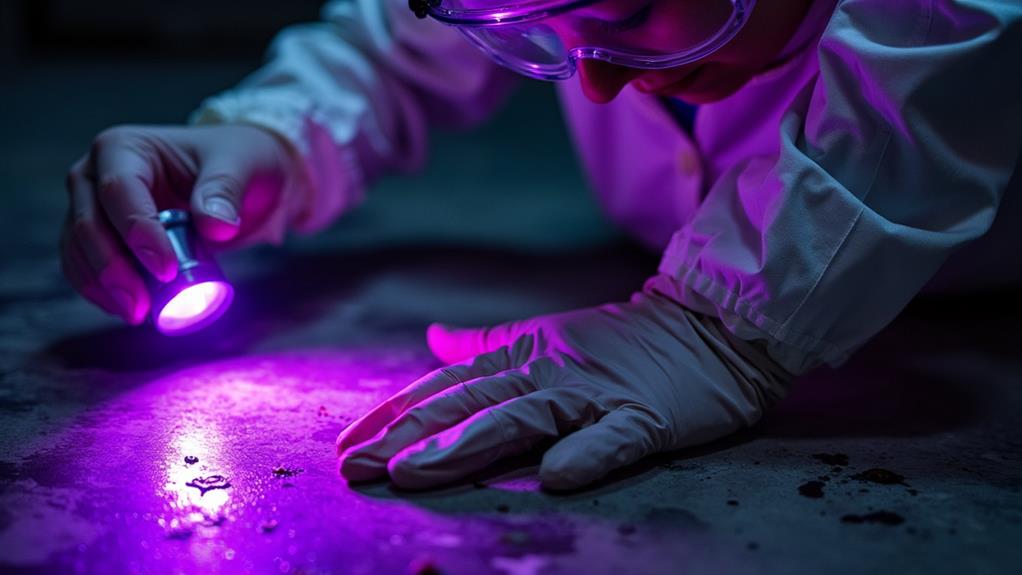
When using purple flashlights, prioritizing safety is crucial. These devices emit UV radiation, which can be harmful if mishandled. Always wear protective eyewear to shield your eyes from potential damage, and avoid direct eye contact with the light source, as prolonged exposure can lead to severe vision problems. Additionally, UV radiation can damage skin, so limit exposure duration.
Keep children and uninformed individuals away from the purple flashlight to prevent accidental UV radiation exposure. Educating others about these dangers is essential. Regularly inspect the flashlight to ensure it's in good working condition and assess whether its use is necessary.
Preventive measures are your best defense. By understanding UV light's potential effects, you can take appropriate steps to protect yourself and others. Remember, safety involves not only your actions but also maintaining awareness of those around you. Proper use and care of your purple flashlight will help you avoid the risks associated with UV exposure.
General Usage Guidelines
Purple flashlights are invaluable for detecting fluorescence in various materials, such as pet stains, counterfeit currency, and bodily fluids. To ensure effective and safe operation of your UV flashlight, adhere to the following guidelines:
- Use in Darkness: Operate your purple flashlight in a dark environment to enhance the visibility of fluorescing objects. The contrast between UV light and a dark background is essential for detecting significant amounts of fluorescent material, such as pet urine or leaks.
- Regular Maintenance: Keep the lens clean and store your flashlight in a cool, dry place to ensure peak performance and prolong its lifespan. Neglecting maintenance can lead to reduced efficiency and a shorter lifespan.
- Safety Precautions: Always wear UV-blocking safety goggles to protect your eyes from harmful ultraviolet light. Limit exposure to your skin and eyes, as even brief exposure can be risky, particularly during extended use.
Key Takeaways:
- Operate in darkness for better visibility.
- Maintain and store properly to extend lifespan.
- Use safety goggles to protect your eyes.
Common UV Flashlight Applications
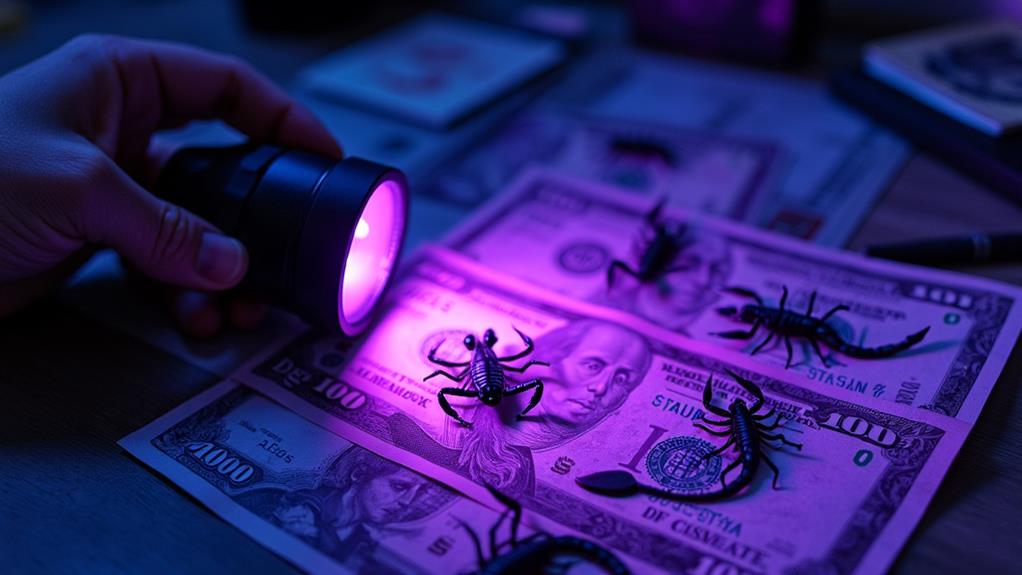
UV flashlights, known for their ability to illuminate the unseen, have a wide range of practical applications across multiple fields. In the realm of finance, these flashlights are invaluable for detecting counterfeit bills. The ultraviolet light they emit reveals hidden security features in U.S. currency, making it easier to identify fake bills on the spot.
For pet owners, UV flashlights offer a straightforward solution for locating and cleaning up messes. Pet urine stains, which fluoresce under UV light, become easily visible, allowing for more effective cleaning.
In forensic investigations, UV flashlights are indispensable for uncovering hidden evidence. They can reveal bodily fluids and enhance the visibility of latent fingerprints, providing crucial clues for solving crimes.
Automotive maintenance also benefits from UV flashlights. When used with fluorescent dyes, these flashlights can help detect fluid leaks such as refrigerant or motor oil. Additionally, mineral and gemstone enthusiasts find UV flashlights useful for identifying fluorescent minerals, which glow vividly under ultraviolet light.




